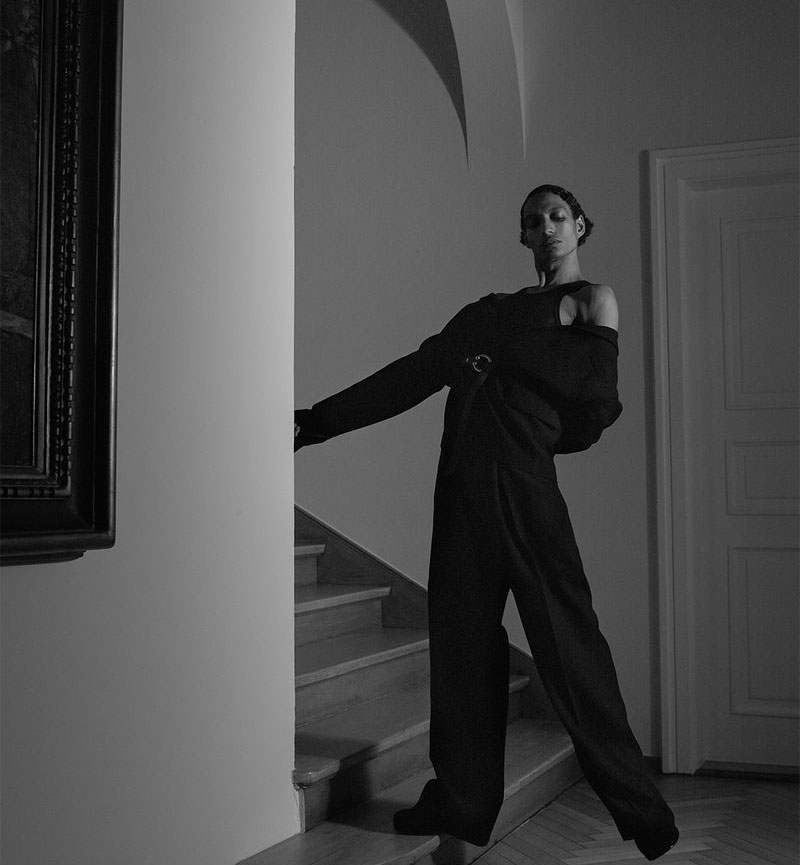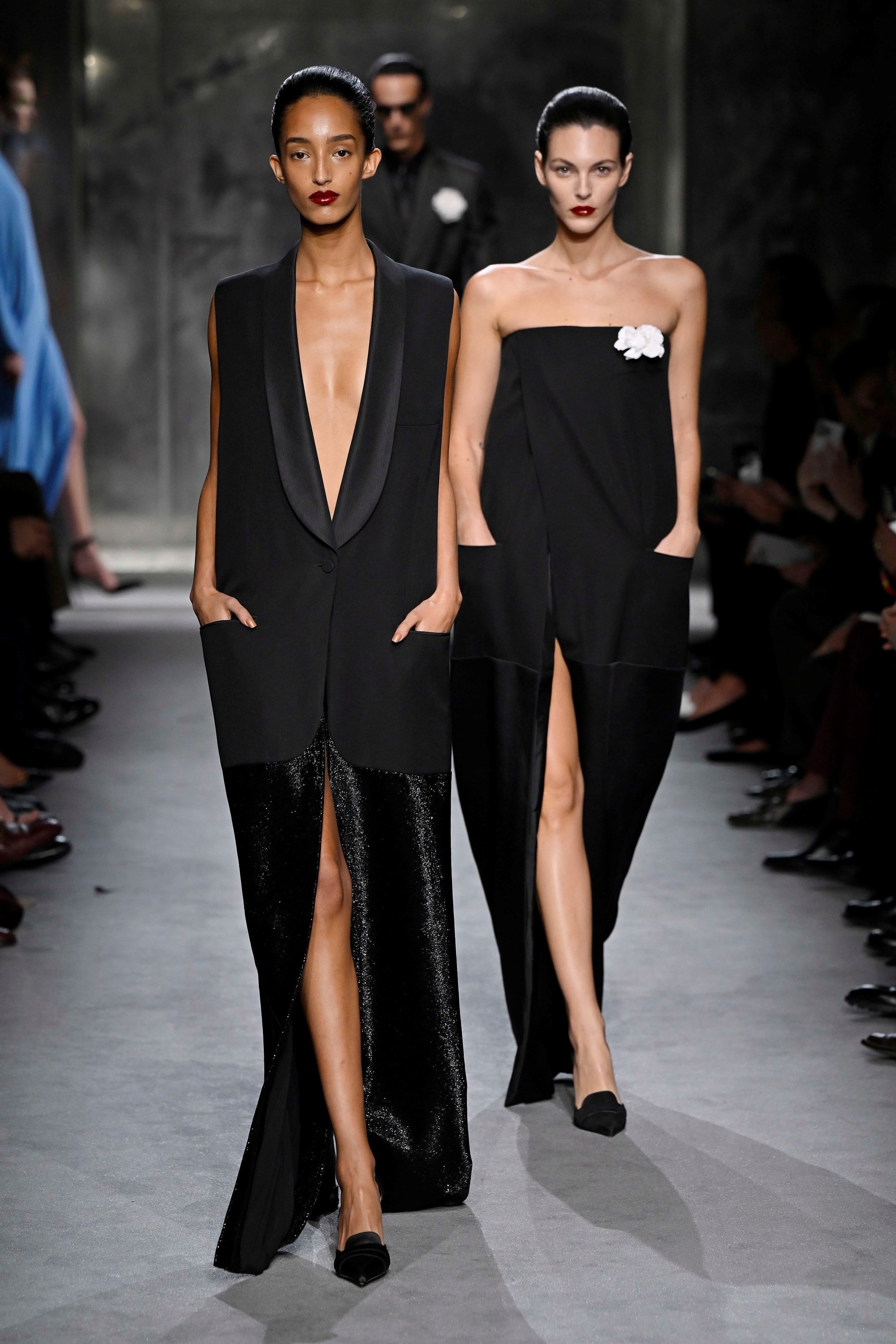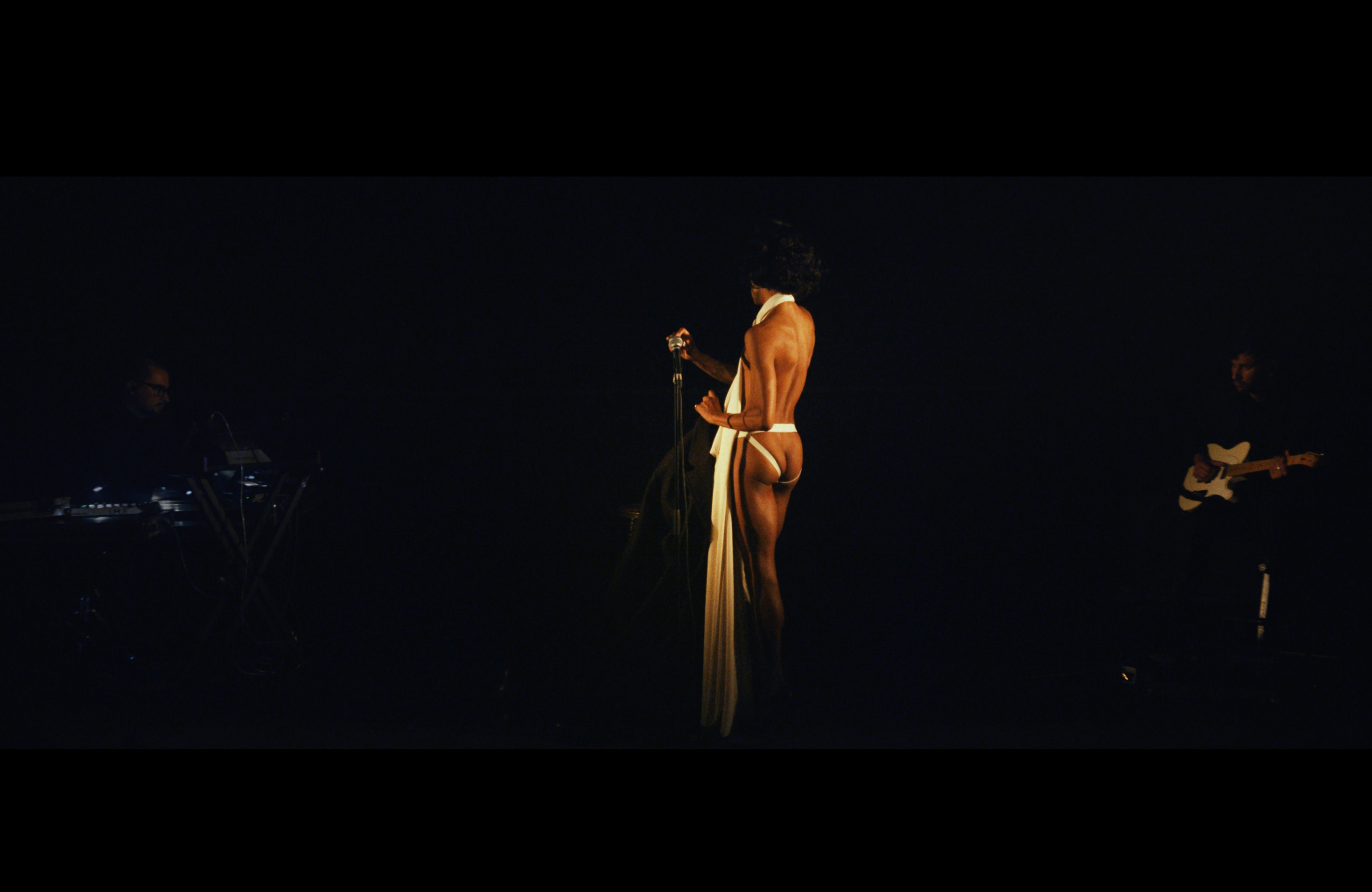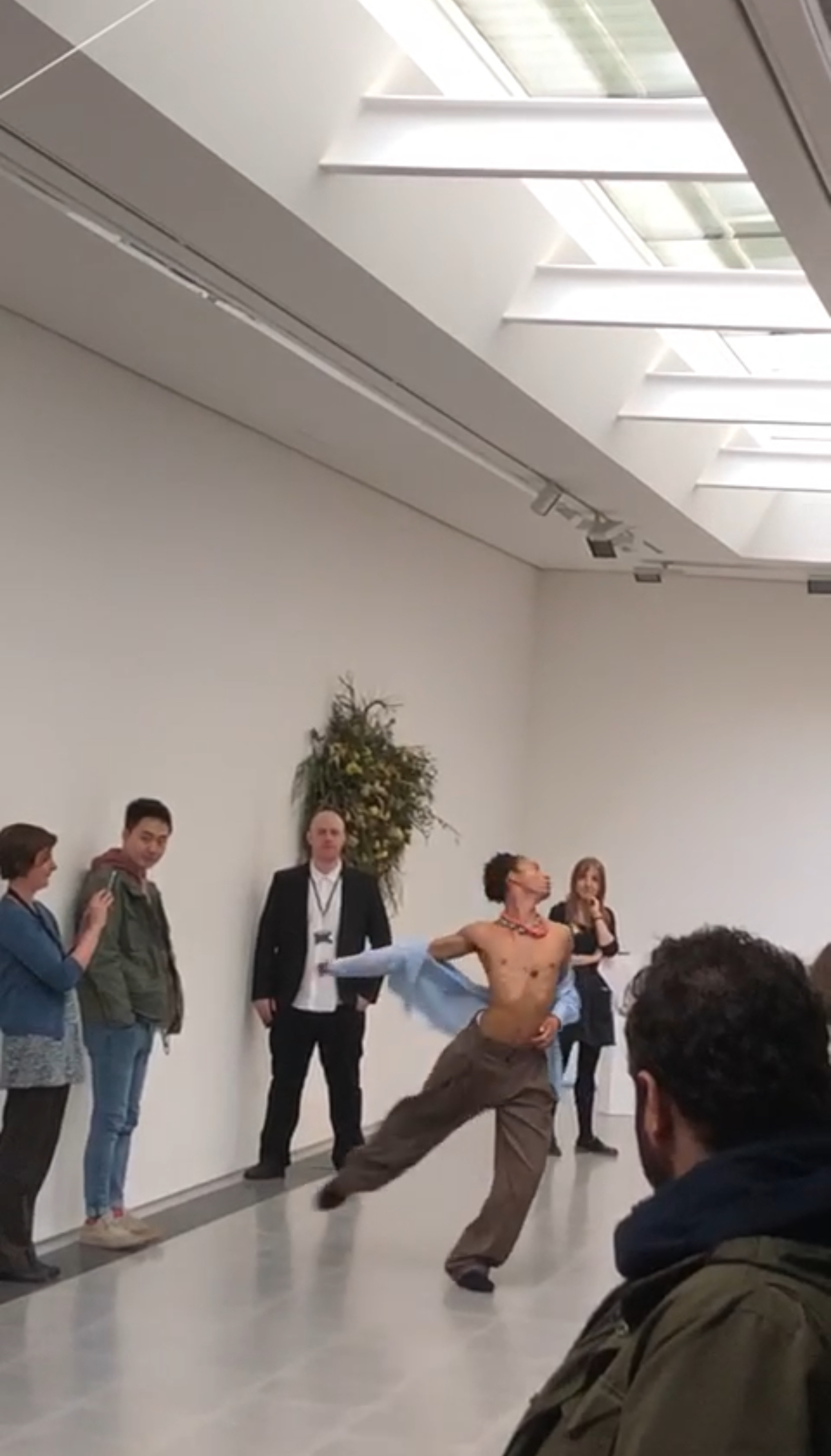Behind the Image is an ongoing MODELS.com series taking a more personal look at both established and emerging creative talent.

MJ Harper by Jacqueline Landvik | Image courtesy of nest model management
MJ Harper, Movement Director
Hometown: Jamaica/Florida
Based: Berlin, Germany
Representation: nest model management & Concrete Rep Limited
How would you describe your work?
Tanztheater (meaning “dance theatre” in German) for the algorithmic age meets sculpture.
What sets your approach apart?
What sets my approach apart is that my movement direction is an extension of my art and performance practice. I’ve grown up in theaters and have had the privilege of working with major international institutions, including Alvin Ailey II, Company Wayne McGregor, BayerischeStaats Oper, and the Komische Oper in Berlin. Alongside that, I’ve collaborated with esteemed designers, photographers, stylists, and art directors such as Martine Rose, the Fendi family, Haider Ackermann, GmbH, Glenn Martens, David Sims, Tim Walker, Glen Luchford, Melina Matsoukas, Luis Alberto Rodriguez, Nell Kalonji, Tamara Rothstein, Harry Lambert, and Christopher Simmonds, to name a few. Each of these experiences has shaped how I understand the mind, body, and spirit-and how I bring that understanding into the work.
When did your passion for dance first begin, and how did it evolve into your career as a movement director?
Dance has been omnipresent in my entire life. I was born on the island of Jamaica, where dance and music are integral to the culture. There’s an innate sensuality in everything; in that sense, it has always been part of my DNA. With encouragement from two key figures in life-my mother and my theatre teacher, Lori Sessions- I began the journey toward a formal dance career. During my time with Company Wayne McGregor, I had the chance to witness and contribute to Wayne’s creative brilliance. Collaboration is one of his many strengths, and fashion is a world he actively engages with. In London, I had a fateful meeting with a newly graduated LVMH prize winner, Grace Wales Bonner. She asked if I’d be interested in stepping in as her movement director for the upcoming season. It was the first time I had taken on that role, and from there, our relationship grew into something I hold in the highest regard. It became the catalyst for an entirely new world that opened for me.
You started your career as a model before transitioning into movement direction, how has that background influenced or shaped your approach to movement direction?
It all started quite ‘accidentally.’ Modeling came about through being in conversation with a community of people, first in London, then Berlin, and Milan. These individuals have blossomed and continue to blossom into the most extraordinary humans. In London, I was photographed by Bertil Nilsson, Matthew Stone, Daniel Sannwald, and Jacob Sutton. Neil Barrett featured me in my first designer campaign. Grace Wales Bonner, Stefano Pilati, and Edward Buchanan were among the first to invite me onto their runway, an honor I’ll never forget. Matt Lambert gave me my first experience on larger commercial sets as a movement director while also becoming a collaborator on our shared creative endeavors. I’m forever grateful to each of them for gracefully welcoming me into their worlds. The training I received from Company Wayne McGregor, married with the information I started to receive on fashion shoots and shows, helped to shape an empathetic body, one I now draw from in my work as a movement director. Being close to the process, working with various production companies, and witnessing the technical care required to bring a vision to life gave me a sense of clarity. It taught me how to tune into the frequencies of high-pressure creative environments and how to offer calm and clarity in those spaces, so that others can feel safe, supported, and free.
“Arias For a New World” was 12 years in the making and debuted in 2023. Can you speak on the process of creating the film and the inspiration behind it?
I am still processing it all. It’s been one of the most profound experiences of my life, and at times, it feels like it came from somewhere else. The work, a solo piece of Tanztheater, traverses movement and a monologue composed of subconscious streams of thought. Written and directed by me, it is set to a film score made and performed in real-time by composers and musicians Antonio Komasa-Lazarkiewicz and Thomas Moked Blum. It tells the story of my mother and me immigrating from Jamaica to the United States through the lens of a Southern belle who was once a stage performer. The stage version began through early collaborations with Stefano Pilati, Kenny Campbell, and Matt Lambert, whose contributions were central to its development. It debuted at the Berliner Ensemble in 2022. Matt and I then developed a version for film, which opened the door to a beautiful collaboration with Kim Jones, Katy England, Ali Pirzadeh, and Gainsbury + Whiting. This version was presented live at KOKO in Camden, captured through the lens of Matt Lambert and D.O.P. Jack Hamilton, and ultimately transformed into a film. I am working towards bringing work to the stage again!
What non-fashion influences (art, film, literature, music, etc.) shape your creative perspective?
The world of cinema deeply inspires me. Much of what I do in my performance and art practice is shaped through the lens of film. I deeply respect the cinematic gaze of artists like Federico Fellini, Luchino Visconti, Barry Jenkins, Alice Rohrwacher, Terrence Malick, Pina Bausch, and Matthew Barney. Their work continues to influence how I see and create. I am also an avid reader, researcher, and huge music fan. In general, I enjoy the process of world-building. I’m always gathering fragments from different disciplines that spark something in me, combining them to propose new ways of seeing and thinking.
What are some of the biggest challenges you’ve faced professionally, and how have they shaped your growth?
Boundaries. I believe a sense of servitude towards dominant powers has long shaped the role of a dancer in Western society. Movement is an unspoken language, and grey areas tend to be exploited in ‘silence’. Within an art historical context, if we consider Degas’s famed paintings of ballerinas of the Paris Opera Ballet, the socio-economic realities behind the imagery were weighty. Known as ‘les petits rats’ and coming from working-class backgrounds, many of these young women were subject to the gaze and at times the advances of wealthy male patrons. As I have said in previous interviews, it’s important to note that dancers have been known to be the first to show up, the last to leave, and the least to be paid. It hasn’t always been pretty. Still, I feel quite proud and humbled by the support that is around me. We live in a time when the collective is increasingly skilled at naming issues yet still finding its way toward sustainable solutions. In my way, I have tried my best to engage in challenging dialogues on the interpersonal level, doing my best to navigate this path forward with dignity, clarity, and care. It’s incredibly beautiful to see how the role of a ‘dancer’ has shifted in contemporary society and to see a growing sense of respect, recognition, and empowerment for all movement practitioners.
What do you love about what you do?
The traces of memory it has the potential to leave behind in others. Physically, emotionally, mentally, and spiritually.
How do you use movement to convey emotion in a show, campaign, or editorial?
This is a beautiful question. I’m learning that my strength lies in the nuance of the worlds I have been invited to contribute to. When working closely with designers and their respective teams, I try my best to evoke the spirit of the characters or ideas I’m engaging with while also allowing the personal signature of the subject embodying that spirit to emerge, gently entering the environment created for them to inhabit. In a way, it almost feels like working through the lens of both sculpture and cinema at once. It’s essential to me that, no matter the world, the characters leave you feeling like they have imprinted themselves on you somehow. Equally important is that the subject feels like they have arrived at that space within themselves through their own discovery-by way of my guidance.
How do you adapt your direction to work with different types of talents—whether new faces, seasoned professionals, or non-traditional models?
There’s a well-known song by the late Roberta Flack, ‘The First Time Ever I Saw Your Face.’ I often think about that idea when working with someone, whether they are seasoned or not. Whenever I engage with a subject, I try to meet them as if it’s the first time. To me, that means allowing space for the same tenderness, reverence, care, and respect that a ‘first time’ deserves. Collectively, we are all navigating a lot in very slippery times. It’s important to me that people feel safe- that whatever they’ve experienced before entering the space, the time we share together can feel suspended, like time standing still. We can create a sense of eternity through clear focus and intention.
What’s one thing outside of your work that you would like people to know about you?
I am quite shy and enjoy periods of solitude. I am also a big snack monster.
How has the role of movement evolved in fashion, and how do you see it shaping the future of storytelling in the industry?
Stephen Galloway, who has in many ways been a kind of fairy aunty, continues to be a pioneer in shifting a space that has long existed yet remained largely invisible. Photographers Inez and Vinoodh, who helped carve out that space for Stephen to share his magic with the world, have been integral to the role of the movement director shifting the industry’s evolution. Together, they’ve helped propose another way of building worlds through collaboration, trust and vision. More and more, I find that fashion houses, designers, photographers, art directors, stylists, casting directors, model agencies, production companies, and even journalists and magazines, are beginning to make space for the presence of the movement director as an active and vital contributor to the fabric of the industry. By including movement direction as part of the creative conversation in world building, we’re also proposing a new community model to the wider public: a community that honors connectivity, collaboration, and care. One that ultimately invites a new way of being with each other.
Selected Work

Mona Tougaard & Vittoria Ceretti | Image courtesy of Tom Ford & nest model management
Tom Ford F/W 25 Show
Here we have Mona Tougaard, Vittoria Ceretti, Scott Barnhill, and Lulu Tenney. I still don’t have the words to describe how moved I am by the fact that I was able to be a part of this, I am extremely grateful to Haider Ackermann for his trust and the cast! Compositionally, this is one of my favourite shows I’ve done so far. I am very proud of what we were able to do. Haider’s desire and willingness to approach a fashion show with a dramaturgical perspective through a contemporary lens and his innate sensuality created such a harmony with the legacy of Mr. Tom Ford. I am truly so excited for all that will continue to come from this marriage.

Florence + The Machine | Image courtesy of BBC / Andy Paradise & nest model management
Florence + The Machine BBC Proms
Another, I still can’t believe this happened. Florence was the most gracious human and truly held a frequency of the highest of qualities. Jules Buckley’s orchestra and London Contemporary Voices all gave me continued waves of goosebumps during rehearsals. I always dreamt of being able to do a project in the Royal Albert Hall. I never in my wildest dreams thought it would be this.

MJ Harper | Image courtesy of MJ Harper & Matt Lambert & nest model management
Arias For A New World
This image is from a very precious moment in the work—a tender point after quite a climax in the monologue and music. The work traverses waves of nuance, and I love how the dress designed by Kim Jones and styled by Katy England falls and also reveals a special surprise. The jock strap is a signature from previous iterations of the work and one of the many ambiguous glitches in the work that blurs different lines of reality. Working on this production with Matt Lambert was a personally significant point for both of us, and the creative team that gathered around us is the actual definition of what it means to show up with love.

By Jason Lloyd-Evans| Image courtesy of nest model management
‘Random Identities’ Pitti Uomo
No one would have anticipated that shortly after this presentation, our lives would change forever. A global shift soon followed, and our time together under Random Identities became truly transformative and foundational. Stefano bestowed upon us, and gifted us, a masterclass in a language and legacy that, alongside my time working with Wayne McGregor in London, remains one of the greatest honors of my life. Not a day goes by that I do not walk with his lessons.

MJ Harper | Image courtesy of nest model management
Serpentine: An Exercise In Balance
Grace Wales Bonner curated a seminal show at The Serpentine called ‘A Time For New Dreams’. She was incredibly gracious and invited me to create a live intervention within the exhibition. I was granted five days in total and was in the company of prolific artists such as David Hammons, Liz Johnson Artur, Eric N. Mack, and Ishmael Reed. The work I contributed, ‘An Exercise In Balance’, was created in real time as guests visited the exhibition over four days. On the fifth day, I presented a more formal piece–a composite drawn from the material I developed throughout the residency. This became a critical moment for me. It helped solidify a performance language I had been nurturing in Berlin, and marked the early beginnings of ‘Arias For A New World’. Looking back, it holds even deeper meaning, as my interactions with audience members were quite intimate, and just a year later, we would all find ourselves unable to relate to one another in public spaces in the same way again.







